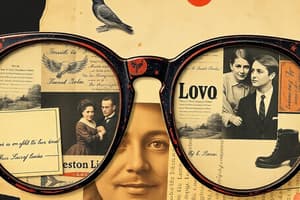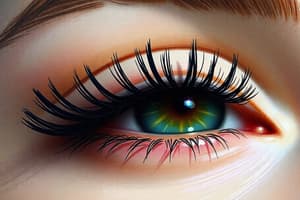Podcast
Questions and Answers
What primary historical role were early lenses believed to fulfill, besides vision correction?
What primary historical role were early lenses believed to fulfill, besides vision correction?
- Serving as currency
- Acting as burning glasses (correct)
- Aiding in surgery
- Creating decorative jewelry
What type of refractive error could the first eyeglasses correct?
What type of refractive error could the first eyeglasses correct?
- Myopia only
- Hyperopia and presbyopia (correct)
- Myopia and astigmatism
- Astigmatism only
What is the significance of Salvino D'Armato degli Armati in the history of spectacles?
What is the significance of Salvino D'Armato degli Armati in the history of spectacles?
- Legend attributes him as the inventor of spectacles. (correct)
- He funded early lens grinding research.
- He standardized lens measurements.
- He was the first to describe the optics of lenses.
In which century did Spanish craftsmen introduce temples to eyeglass frames, and what materials were initially used to secure them?
In which century did Spanish craftsmen introduce temples to eyeglass frames, and what materials were initially used to secure them?
Who is credited with designing the first lenses to correct for astigmatism, and in what year?
Who is credited with designing the first lenses to correct for astigmatism, and in what year?
What was the 'reading stone,' and around what time period did it appear?
What was the 'reading stone,' and around what time period did it appear?
What is the key feature that distinguishes pince-nez eyeglasses, believed to have appeared in the 1840s, from other early forms of eyewear?
What is the key feature that distinguishes pince-nez eyeglasses, believed to have appeared in the 1840s, from other early forms of eyewear?
Who invented bifocal lenses, and in what year?
Who invented bifocal lenses, and in what year?
What significant development did Edward Scarlett introduce to eyeglasses between 1727 and 1730?
What significant development did Edward Scarlett introduce to eyeglasses between 1727 and 1730?
Which of the following best describes the contribution of Italian or Spanish missionaries to the history of eyeglasses?
Which of the following best describes the contribution of Italian or Spanish missionaries to the history of eyeglasses?
What was the primary function of early plano-convex lenses made of polished rock crystal?
What was the primary function of early plano-convex lenses made of polished rock crystal?
Which Roman philosopher is noted for using a globe of water as a magnifying tool?
Which Roman philosopher is noted for using a globe of water as a magnifying tool?
What distinguishes the lorgnette from other early forms of vision correction?
What distinguishes the lorgnette from other early forms of vision correction?
What was a unique adaptation made by the Chinese when eyeglasses with temple attachments were introduced by missionaries?
What was a unique adaptation made by the Chinese when eyeglasses with temple attachments were introduced by missionaries?
What is the significance of the year 1784 in the historical development of lenses and eyeglasses?
What is the significance of the year 1784 in the historical development of lenses and eyeglasses?
What material were the earliest lenses primarily made from, and what shape did they typically have?
What material were the earliest lenses primarily made from, and what shape did they typically have?
Aside from vision correction, what other practical use is documented for early magnifying devices by Pliny?
Aside from vision correction, what other practical use is documented for early magnifying devices by Pliny?
What was the primary optical characteristic of lenses developed in the 14th century for correcting myopia?
What was the primary optical characteristic of lenses developed in the 14th century for correcting myopia?
Which development in eyeglass design is associated with Englishman George Adams?
Which development in eyeglass design is associated with Englishman George Adams?
How did the design and purpose of monocles differ from other eyewear options available in the 18th century?
How did the design and purpose of monocles differ from other eyewear options available in the 18th century?
What vision condition could the first eyeglasses correct?
What vision condition could the first eyeglasses correct?
What was the unique feature of the 'temple glasses' perfected by Edward Scarlett?
What was the unique feature of the 'temple glasses' perfected by Edward Scarlett?
In what century did the first form of eyeglasses appear?
In what century did the first form of eyeglasses appear?
What was the first type of lens used for myopia correction?
What was the first type of lens used for myopia correction?
Who developed the solid upcurve bifocal lens?
Who developed the solid upcurve bifocal lens?
Who invented the blended bifocal?
Who invented the blended bifocal?
When were trifocal lenses introduced?
When were trifocal lenses introduced?
Which lens was the first progressive multifocal lens and who created it?
Which lens was the first progressive multifocal lens and who created it?
When were D-Bifocals introduced?
When were D-Bifocals introduced?
Which innovation in eyewear is attributed to Benjamin Franklin?
Which innovation in eyewear is attributed to Benjamin Franklin?
Where did the first eyeglasses originate during the 12th to 13th century?
Where did the first eyeglasses originate during the 12th to 13th century?
When were eyeglasses first used for myopia correction?
When were eyeglasses first used for myopia correction?
What material was often used in early eyeglass frames during the time of the Venetians?
What material was often used in early eyeglass frames during the time of the Venetians?
Besides vision, what other purpose did Romans use glass bowls of water for?
Besides vision, what other purpose did Romans use glass bowls of water for?
During what time period did Spanish artisans add temple pieces to eyeglass frames?
During what time period did Spanish artisans add temple pieces to eyeglass frames?
Flashcards
Early Optometry History
Early Optometry History
Optometry's early history involved opticians correcting refractive errors using lenses.
Oldest Known Lens
Oldest Known Lens
A plano-convex piece of polished rock crystal, 3.8 cm in diameter with a focal length of 11.5 cm found in the ruins of Nineveh. It Dates back to 1200 B.C.
Romans as Magnifiers
Romans as Magnifiers
They used glass bowls of water as magnifiers.
Inventor of Spectacles (Legend)
Inventor of Spectacles (Legend)
Signup and view all the flashcards
Seneca's Magnifier
Seneca's Magnifier
Signup and view all the flashcards
First Magnifying Glass
First Magnifying Glass
Signup and view all the flashcards
First Eyeglasses Use
First Eyeglasses Use
Signup and view all the flashcards
14th Century Eyeglasses
14th Century Eyeglasses
Signup and view all the flashcards
16th Century Glasses
16th Century Glasses
Signup and view all the flashcards
Edward Scarlett's Glasses
Edward Scarlett's Glasses
Signup and view all the flashcards
Sir George Airy
Sir George Airy
Signup and view all the flashcards
18th Century Monocle
18th Century Monocle
Signup and view all the flashcards
The Lorgnette
The Lorgnette
Signup and view all the flashcards
Pince-nez
Pince-nez
Signup and view all the flashcards
Bifocal Lenses Inventor
Bifocal Lenses Inventor
Signup and view all the flashcards
Trifocal lenses
Trifocal lenses
Signup and view all the flashcards
Solid Upcurve Bifocal Inventor
Solid Upcurve Bifocal Inventor
Signup and view all the flashcards
Perfection Bifocal
Perfection Bifocal
Signup and view all the flashcards
Cemented Bifocal
Cemented Bifocal
Signup and view all the flashcards
Fused Bifocal (Kryptok)
Fused Bifocal (Kryptok)
Signup and view all the flashcards
Ultex Bifocal
Ultex Bifocal
Signup and view all the flashcards
D-Bifocals (Flat-top bifocal)
D-Bifocals (Flat-top bifocal)
Signup and view all the flashcards
Executive Bifocals
Executive Bifocals
Signup and view all the flashcards
Blended Bifocal
Blended Bifocal
Signup and view all the flashcards
First progressive multifocal lens (Varilux)
First progressive multifocal lens (Varilux)
Signup and view all the flashcards
Study Notes
History of Lenses and Eyeglasses
- The history of optometry is linked to opticians' work, as correcting refractive errors depended on lens experiments.
- The oldest known lens: a plano-convex piece of polished rock crystal, 3.8 cm in diameter, with a focal length of 11.5 cm was found in Nineveh ruins, dating back to 1200 B.C.
- Lenses were more likely used as burning glasses than vision aids.
- Philosopher Pliny noted their use by physicians for cauterizing wounds.
- Romans used glass bowls of water as magnifiers.
- The inventor of spectacles is unknown, though a legend exists of an Italian named Armato degli Armati, supported by his tombstone inscription.
- Roman philosopher Seneca (4 B.C – 65AD) used a globe of water as a magnifier to read "all the books of Rome".
- The first magnifying glass, a monk's reading stone, appeared around 1000 A.D.
- This was a glass sphere segment to magnify letters, and allowed the presbyopic monks to read.
- First eyeglasses made in Italy (Venetians) by monks or craftsmen in Pisa around 1285-1289, during the 12th to 13th century
- Magnifying lenses for reading were shaped like two small magnifying glasses that were set into wood, metal, or leather mountings and balanced on the bridge of nose.
- First eyeglasses only corrected hyperopia and presbyopia.
- 14th century: Eyeglasses for myopia appeared and were mounted with biconcave lenses.
- 16th century: Spanish craftsmen created the first eyeglass frame temples, attaching ribbons/strings to loop over the wearer's ears.
- Spanish and Italian missionaries brought eyeglasses to China, where weights were added to the strings rather than loops.
- British optician Edward Scarlett perfected "temple glasses" between 1727 and 1730, equipped with temples that pressed on the sides of the head, ending in loops.
- 1825: Englishman Sir George Airy designs the first lenses to correct astigmatism.
- 18th century: The monocle (eye ring) was introduced in England.
- Monocles were popular among upper-class European men in the 1800s.
- The lorgnette, two lenses in a frame with a lateral handle, was an 18th-century development.
- It was developed by Englishman George Adams
- Pince-nez are believed to have appeared in the 1840s, and consist of oval lenses without side-arms, relying on nose support for stability.
History of Bifocal Lenses
- 1784: Bifocal lenses were invented by Benjamin Franklin (Franklin Split Bifocal).
- 1826: Trifocal lenses were introduced by John Isaac Hawkins.
- 1837: Solid Upcurve Bifocal (1st one-piece bifocal) was made by Isaac Schnaitman.
- 1888: Perfection Bifocal was made by August Morck.
- 1899: Cemented Bifocal was made by John Borsch, Sr.
- 1908: Fused Bifocal (Kryptok) was made by John Borsch, Jr.
- 1910: Ultex Bifocal was made by O'Conner.
- 1915: D-Bifocals (Flat-top bifocal) was made by Henry Courmettes.
- 1954: Executive bifocals were made by an American optical company.
- 1955: Blended bifocal (Invisible bifocal/ Seamless bifocal/ Younger bifocal) was invented by Irvin Rips
- 1958-1959: The first progressive multifocal lens (Varilux) was made by Essilor International of France.
Studying That Suits You
Use AI to generate personalized quizzes and flashcards to suit your learning preferences.




